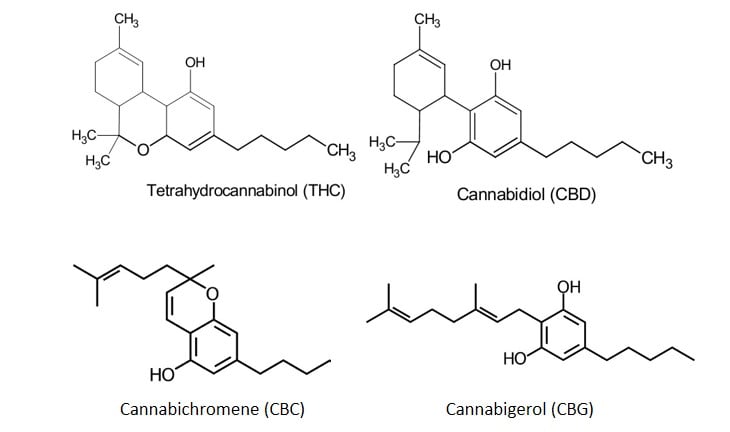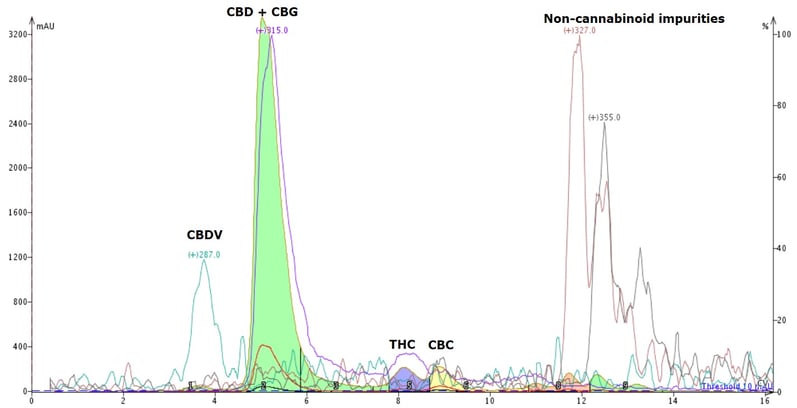Cannabichromene (CBC) is one of the four most prevalent cannabinoids expressed by cannabis plants (Pollastro, 2018). Unlike the psychoactive tetrahydrocannabinol, CBC is benign in this regard, but does have purported health benefits.
Though CBC is a relatively abundant cannabinoid, it has not been studied as extensively as THC and CBD and is extracted in low quantities (Pollastro, 2018). Nonetheless, it is a cannabinoid of serious interest.
While cannabichromene’s chemical structure is distinctly different than that of THC, the two compounds’ hydrophobicities are similar since both have a single phenol and a single ether group, Figure 1. Because of these similarities their chromatographic separation is challenging, but not impossible.

Figure 1. Chemical structures of the four most abundant cannabinoids. Both CBC and THC contain one -OH and one -O- functional group while CBD and CBG have two -OH groups but no -O- groups. The similarities between CBC/THC and CBD/CBG make each of these pairs challenging to separate.
Through some method development exercises, I created a suitable CBC purification method using reversed-phase flash chromatography. This gradient elution method separates CBDV, CBD, THC, and CBC, as well as some non-cannabinoid compounds, Figure 2. However, CBG and CBD co-elute with this methodology but can be separated by normal-phase flash chromatography.

Figure 2. Reversed-phase flash purification of CBC in a CBD-rich solution. This method also separates CBDV from CBD/CBG.
For this work I used a Biotage® Isolera Dalton 2000, which is an automated flash chromatography system with an attached mass detector. I used this flash chromatography system because the attached mass detector verifies cannabinoid molecular weight. However, I used collected UV spectra to delineate and determine compound identity, Figure 3.
Why the two detectors? Because CBD, THC, and CBC share the same molecular formula and, therefore, the same molecular weight (314). The mass detector is not a requirement for this work but a UV PDA detector is. The two available Biotage flash systems, Isolera and Biotage® Selekt, both contain photo-diode array UV detectors (PDA-UV) which automatically capture real-time UV absorbance spectra for each detected compound. Post run the data can be referenced in the result files to identify compounds.

Figure 3. UV spectra collected during purification is used to identify individual cannabinoids since they have noticeable spectral differences. Left - CBD shows UV maxima at 208 and 276 nm. Center - THC shows UV maxima at 209 and 279 nm. Right - CBC has UV maxima at 231 and 283 nm which are very different than the others.
Though hard to see because picture size and low amount of THC and CBC, the actual spectra are different. The spectral maxima for CBC is unique (UV maxima 231 nm and 283 nm). No other cannabinoid has a UV maxima at 231 nm.
The UV spectra for THC and CBD, though are similar to each other, also have different spectral maxima which enable their identification, making UV analysis a definitive cannabinoid identification tool.
We have other posts and application notes focused on cannabinoid purification. For a good overview of flash chromatography for large scale cannabinoid purification, download the article Building Sustainable Manufacturing Operations - CBD/THC Processing Considerations.

 Organic Workflow
Organic Workflow Peptide Workflow
Peptide Workflow Scale-Up Flash Purification
Scale-Up Flash Purification  Sample Preparation
Sample Preparation Biomolecule Purification
Biomolecule Purification Oligo synthesis
Oligo synthesis Scavengers and Reagents
Scavengers and Reagents Service & Support
Service & Support Accessories & Spare parts
Accessories & Spare parts Investors
Investors Reports & News
Reports & News The Share
The Share Corporate Governance
Corporate Governance Calendar
Calendar Sustainability
Sustainability Our Offering
Our Offering Our History
Our History Our Locations
Our Locations Leadership
Leadership